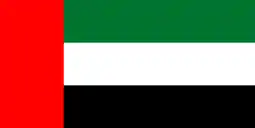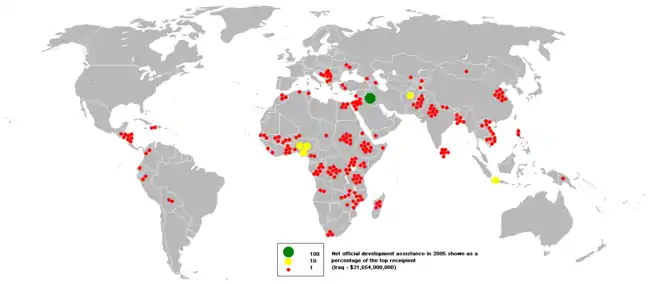Official development assistance
Official development assistance (ODA) is a term coined by the Development Assistance Committee (DAC) of the Organisation for Economic Co-operation and Development (OECD) to measure foreign aid. The DAC first used the term in 1969. It is widely used as an indicator of international aid flow. It includes some loans.
Most ODA comes from the 30 members[1] of the DAC, or about $135 billion in 2013. A further $15.9 billion came from the European Commission and non-DAC countries gave an additional $9.4 billion. Although development aid rose in 2013 to the highest level ever recorded, a trend of a falling share of aid going to the neediest sub-Saharan African countries continued.[2] The United Nations Sustainable Development Goal 10 however aims to rectify this trend by encouraging official development assistance and financial flows to these nations.[3]
Definition
The full definition of ODA is:
Flows of official financing administered with the promotion of the economic development and welfare of developing countries as the main objective, and which are concessional in character with a grant element of at least 25 percent (using a fixed 10 percent rate of discount). By convention, ODA flows comprise contributions of donor government agencies, at all levels, to developing countries ("bilateral ODA") and to multilateral institutions. ODA receipts comprise disbursements by bilateral donors and multilateral institutions.
— OECD, Glossary of Statistical Terms[4]
In other words, ODA needs to contain the three elements:
(a) undertaken by the official sector (official agencies, including state and local governments, or their executive agencies)[5]
(b) with promotion of economic development and welfare as the main objective; and
(c) at concessional financial terms (if a loan, having a grant element of at least 25 per cent).
This definition is used to exclude development aid from the two other categories of aid from DAC members:
- Official Aid (OA): Flows which meet conditions of eligibility for inclusion in Official Development Assistance (ODA), other than the fact that the recipients are on Part II of the Development Assistance Committee (DAC) List of Aid Recipients.
- Other Official Flows (OOF): Transactions by the official sector with countries on the List of Aid Recipients which do not meet the conditions for eligibility as Official Development Assistance or Official Aid, either because they are not primarily aimed at development, or because they have a grant element of less than 25 percent.
Examples:
If a donor country accords a grant or a concessional loan to Afghanistan it is classified as ODA, because it is on the Part I list.
If a donor country accords a grant or a concessional loan to Bahrain it is classified as OA, because it is on the Part II list.
If a donor country gives military assistance to any other country or territory it is classified as OOF, because it is not aimed at development.
A recent OECD DAC Commique has seen the donor community update the definition of ODA to better reflect the Sustainable Development Goals.[6][7]
Countries by development aid given
ODA volumes may be measured absolutely, by the amount transferred, or relatively, as a proportion of the donor country's economy. According to the Organisation for Economic Co-operation and Development (OECD), the top 15 countries (DAC and non-DAC members) giving the highest amounts (in absolute terms) in 2015 are as follows:[8] The European Union accumulated a higher portion of GDP as a form of foreign aid than any other economic union.[9]
 United States – $31.08 billion
United States – $31.08 billion United Kingdom – $18.70 billion
United Kingdom – $18.70 billion Germany – $17.78 billion
Germany – $17.78 billion Japan – $9.32 billion
Japan – $9.32 billion France – $9.23 billion
France – $9.23 billion Sweden – $7.09 billion
Sweden – $7.09 billion Netherlands – $5.81 billion
Netherlands – $5.81 billion United Arab Emirates – $4.39 billion (non-DAC member)
United Arab Emirates – $4.39 billion (non-DAC member).svg.png.webp) Canada – $4.29 billion
Canada – $4.29 billion Norway – $4.28 billion
Norway – $4.28 billion Turkey – $3.91 billion (non-DAC member)
Turkey – $3.91 billion (non-DAC member) Italy – $3.84 billion
Italy – $3.84 billion Switzerland – $3.54 billion
Switzerland – $3.54 billion.svg.png.webp) Australia – $3.22 billion
Australia – $3.22 billion Denmark – $2.57 billion
Denmark – $2.57 billion
Donor countries by percentage of gross national income
The OECD also lists countries by the amount of ODA they give as a percentage of their gross national income. Seven countries met the longstanding UN target for an ODA/GNI ratio of 0.7% in 2015. The top 15 DAC and non-DAC countries for 2015 are shown below:[8]
 Sweden – 1.40%
Sweden – 1.40% United Arab Emirates – 1.09% (non-DAC member)
United Arab Emirates – 1.09% (non-DAC member) Norway – 1.05%
Norway – 1.05% Luxembourg – 0.93%
Luxembourg – 0.93% Denmark – 0.85%
Denmark – 0.85% Netherlands – 0.76%
Netherlands – 0.76% United Kingdom – 0.71%
United Kingdom – 0.71% Finland – 0.56%
Finland – 0.56% Turkey – 0.54% (non-DAC member)
Turkey – 0.54% (non-DAC member) Switzerland – 0.52%
Switzerland – 0.52% Germany – 0.52%
Germany – 0.52%.svg.png.webp) Belgium – 0.42%
Belgium – 0.42% France – 0.37%
France – 0.37% Ireland – 0.36%
Ireland – 0.36% Austria – 0.32%
Austria – 0.32%
The average for European Union countries that are DAC members – 0.47%[10]
Aid recipients

World Bank reports that Iraq was the top recipient of development aid in 2005 followed by Nigeria. However, this is due to the significant debt relief deals that were granted to these nations that year - when donor countries write off a portion of a recipient country's debt, it is counted as official development assistance from the donor country.
The OECD reports that in 2009 Africa received the largest amount of ODA, at $28 billion. Of that, $25 billion went to countries south of the Sahara, with Sudan receiving approximately $1.9 billion and Ethiopia getting $1.8 billion. Asia received the second largest amount at $24 billion. The top ODA receiving countries in order were Afghanistan ($5.1 billion), Iraq ($2.6 billion) and Vietnam ($2.1 billion) [11]
According to estimates that the OECD made in 2014, 28 countries with an aggregate population of around 2 billion people will cease to be ODA eligible by 2030. They include emerging markets such as China, Brazil, Mexico, Argentina, Malaysia, Thailand and Turkey. [12]
Criticism
Official development assistance has been criticized by several economists for being an inappropriate way of helping poor countries. The Hungarian economist Peter Thomas Bauer has been one of the most vocal of them. Another notable economist arguing against ODA is Dambisa Moyo in her book Dead Aid. She contends that a country accustomed to receiving ODA may become perpetually dependent on such aid.
Donor countries are most commonly compared by the amount of Official Development Assistance given and their quantity of aid as a percent of GDP. However, there is an increasing focus placed on the quality of aid, rather than simply the quantity. The Commitment to Development Index is one such measure that ranks the largest donors on a broad range of their "development friendly" policies. It takes into account the quality of aid, in addition to the quantity, penalizing countries for tied aid. Aid also does not operate in a vacuum; a country's policies on issues such as trade or migration also have a significant impact on developing countries.
See also
References
- "DAC members". OECD. OECD. Retrieved 14 May 2018.
- "Aid to developing countries rebounds in 2013 to reach an all-time high". OECD. 8 April 2014. Retrieved 18 October 2014.
- "Goal 10 targets". UNDP. Retrieved 2020-09-23.
- OECD Glossary of statistical terms, Official Development Assistance (ODA)
- "Changes to official aid rules - GOV.UK". www.gov.uk. Retrieved 16 April 2018.
- http://www.oecd.org/dac/DAC-HLM-Communique-2016.pdf
- "Development aid in 2015 continues to grow despite costs for in-donor refugees" (PDF). OECD. 13 April 2016. Retrieved 29 April 2016.
- Hunt, Michael (2014). The World Transformed 1945 to the Present. New York: New York. pp. 516–517. ISBN 9780199371020.
- Page 3, excluding the $13.85 billion net disbursements by EU Institutions.
- OECD, "ODA by Recipient", 2011-08-08
- Krempin, Michael. "Beyond the threshold". D+C, Development and Cooperation.
External links
- AidData: Tracking Development Finance
- Official Development Assistance - ODA - OECD.
- The Story of Official Development Assistance (pdf). A history of the DAC by Helmut Führer, former Director of the OECD's Development Co-operation Directorate.
- OECD: Final Official Development Assistance (ODA) data for 2007
- Aidflows